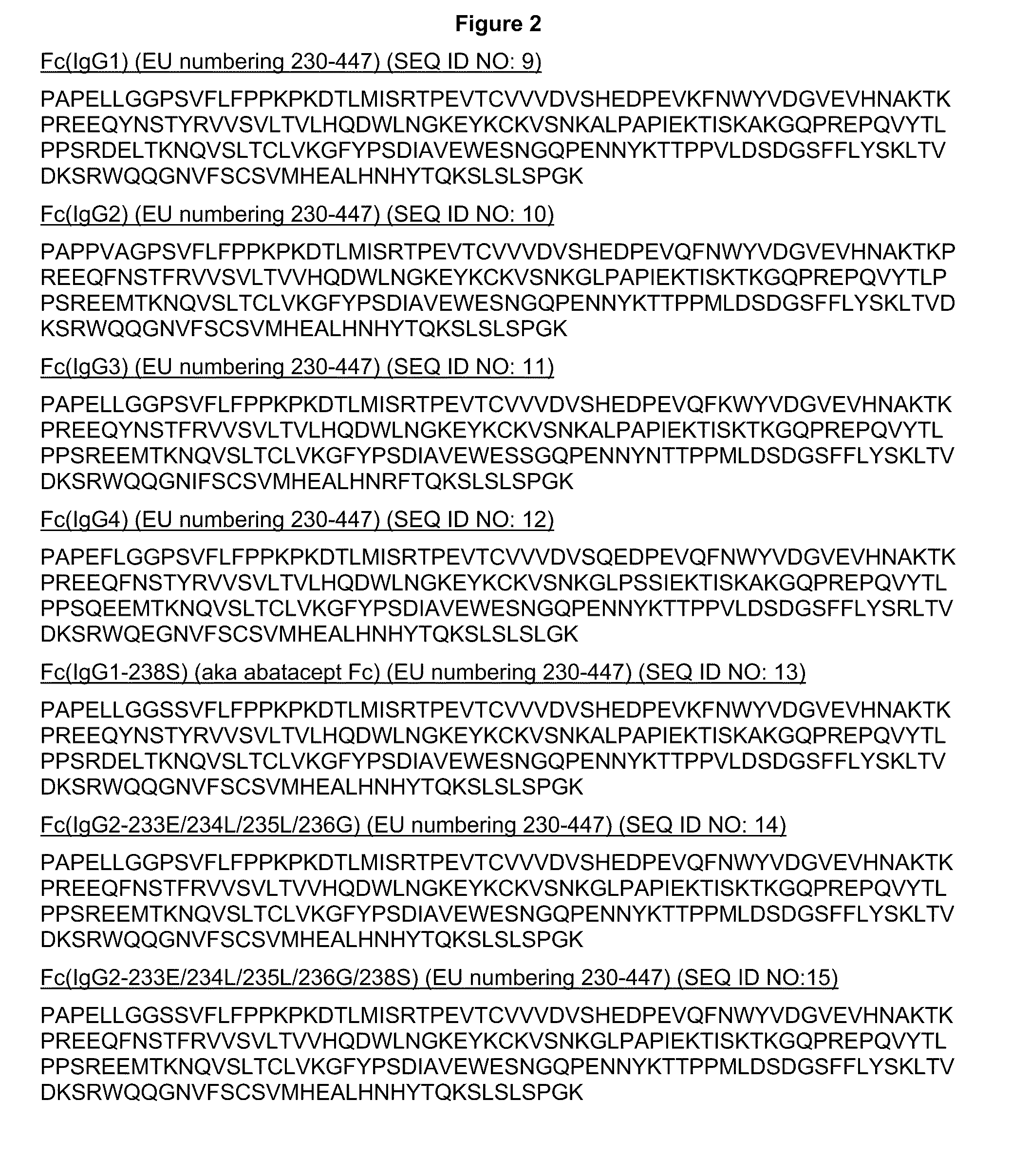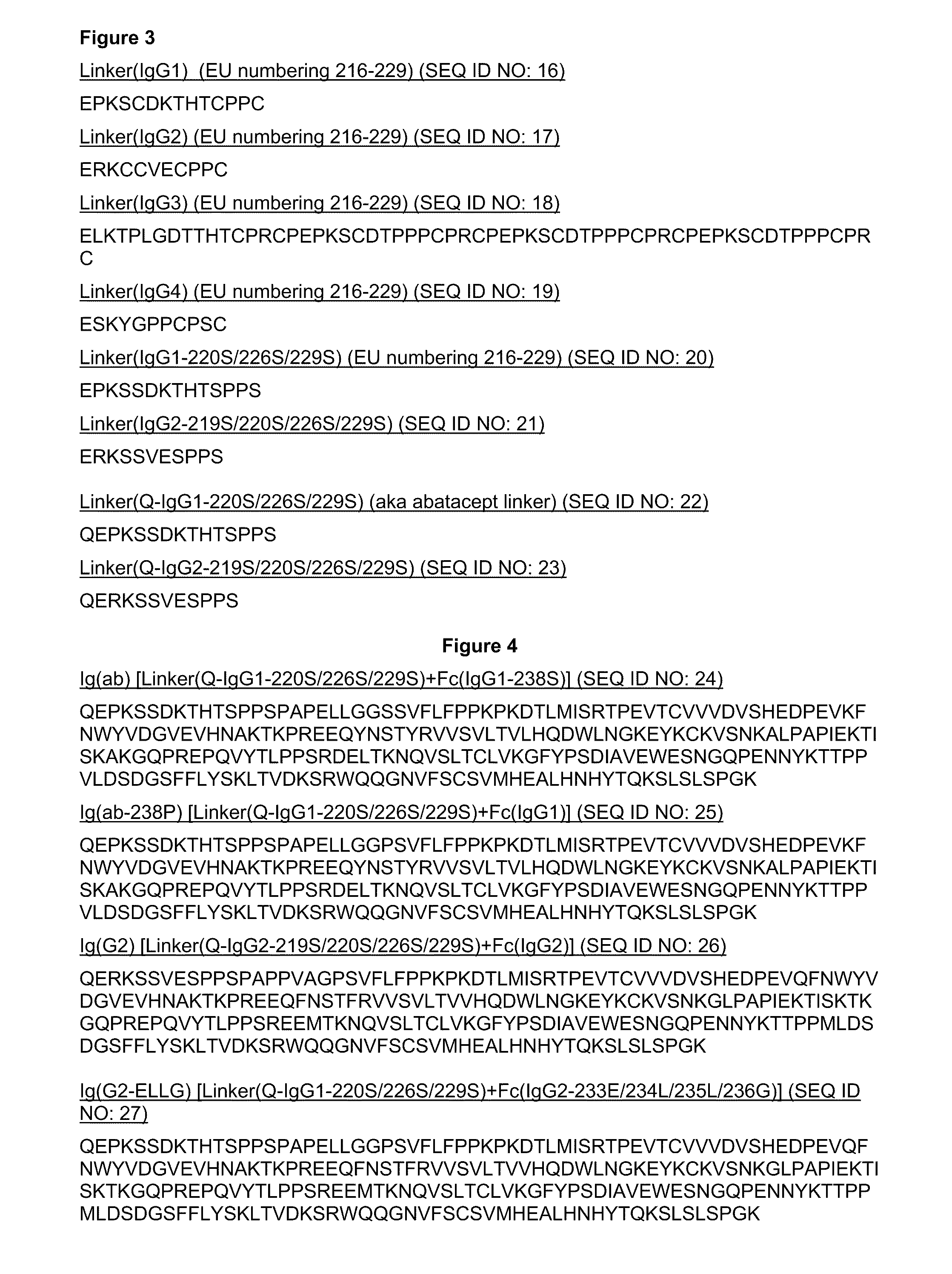CTLA4-Ig immunoadhesins
a technology of immunoadhesins and ctla4ig, which is applied in the field of ctla4ig immunoadhesins, can solve the problems of apoptosis, ineffective for other indications, and inability to induce apoptosis and/or apoptosis
- Summary
- Abstract
- Description
- Claims
- Application Information
AI Technical Summary
Benefits of technology
Problems solved by technology
Method used
Image
Examples
example 1
Engineered CTLA4-Ig Variants that Enhance Binding of B7-1 and B7-2
[0161]The amino acid sequence of full length human CTLA4 is provided in FIG. 1. The extracellular domain (ECD) that is responsible for interaction with B7-1 and B7-2 is also provided in Figurel.
[0162]Immunoadhesins (Fc fusions) of CTLA4 can be constructed by linking the ECD (or some variant of the ECD) to the Fc region of an IgG. The Fc regions of the native human IgG's (IgG1, IgG2, IgG3, and IgG4) are provided in FIG. 2. Although the IgG1 Fc provided in FIG. 2 contains the 356D / 358L haplotype, other haplotypic or allotypic forms may be used (for example 356E / 358M). The Fc region herein is defined as position 230 to the C-terminus based on the EU numbering scheme. Abatacept is an immunoadhesin of CTLA4 linked to a modified IgG1 containing a P238S substitution (referred to as Fc(IgG1-238S in FIG. 2). The CTLA4-Igimmunoadhesins of the invention may include a serine or proline at position 238 (i.e. CTLA4-Ig immunoadhesin...
example 2
Engineered CTLA4-Ig Variants have Greater T-cell Inhibitory Activity in vitro
[0177]The NEQ and HNEQ variant CTLA4-Ig proteins were tested in a cell-based assay for their capacity to inhibit T-cell proliferation. Abatacept, belatacept, and an anti-RSV IgG1 antibody with no specificity for B7-1 or B7-2 (negative control) were run as controls. In this assay, T cell activation and proliferation were stimulated using the anti-CD3 antibody OKT3 and recombinant B7-2 Fc fusion (R & D Systems). U shape tissues culture plates were coated with 2 ug / ml CD86-Fc and 0.5 ug / ml anti-OKT3 in PBS at 4° C. overnight. Plates were washed 3× with PBS. Human peripheral blood mononuclear cells (PBMCs) were purified from leukapheresis of anonymous healthy volunteers (HemaCare, VanNuys, Calif.) using Ficoll-Paque™ Plus density gradients (Amersham Biosciences, Newark, N.J.).T cells were isolated from PBMC using an EasySep® Human T Cell Enrichment Kit (StemCell Technologies) and labeled T cells with CSFE (10 u...
example 3
CTLA4-Ig Immunoadhesins with Enhanced Binding to FcRn for Extended in vivo Half-life
[0178]The Fc region of the CTLA4-Ig proteins were engineered to enhance affinity for the neonatal Fc receptor FcRn, with the goal of improving in vivo serum half-life. Fc variants that improve FcRn binding and may provide enhanced pharmacokinetic properties include but are not limited to substitutions at positions 259, 307, 308, 311, 378, 426, 428, 434, and 436 including but not limited to for example 2591, 307Q, 308F, 311I, 311V, 378V, 378T, 426V, 428L, 434S, 434H, 434F, 434Y, 434M, 4361, and 436V (U.S. Ser. No. 12 / 341,769, filed Dec. 22, 2008, herein expressly incorporated by reference). Other variants that increase Fc binding to FcRn include but are not limited to: 250E, 250Q, 428L, 428F, 250Q / 428L (Hinton et al., 2004, J. Biol. Chem. 279(8): 6213-6216, Hinton et al. 2006 Journal of Immunology 176:346-356), 256A, 272A, 286A, 305A, 307A, 311A, 312A, 376A, 378Q, 380A, 382A, 434A (Shields et al, Jour...
PUM
| Property | Measurement | Unit |
|---|---|---|
| pH | aaaaa | aaaaa |
| molecular weight | aaaaa | aaaaa |
| molecular weight | aaaaa | aaaaa |
Abstract
Description
Claims
Application Information
 Login to View More
Login to View More - R&D
- Intellectual Property
- Life Sciences
- Materials
- Tech Scout
- Unparalleled Data Quality
- Higher Quality Content
- 60% Fewer Hallucinations
Browse by: Latest US Patents, China's latest patents, Technical Efficacy Thesaurus, Application Domain, Technology Topic, Popular Technical Reports.
© 2025 PatSnap. All rights reserved.Legal|Privacy policy|Modern Slavery Act Transparency Statement|Sitemap|About US| Contact US: help@patsnap.com



